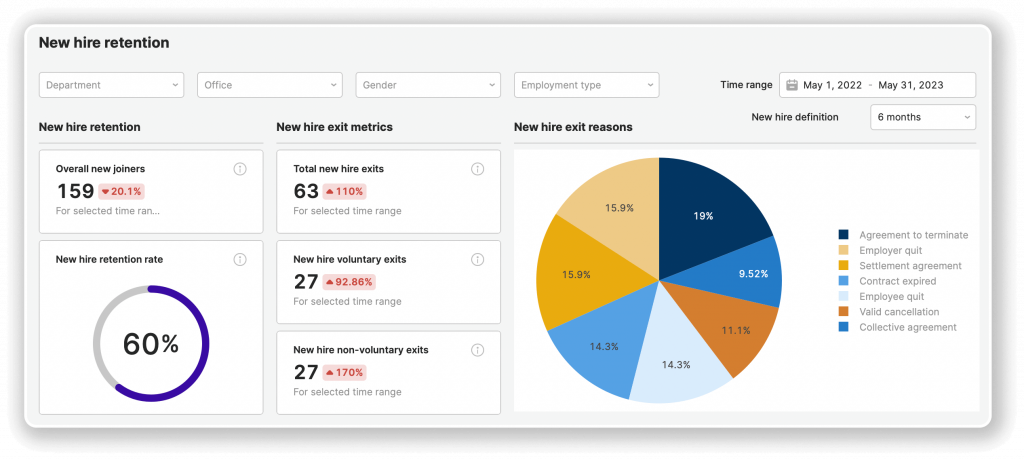21 Dec

People analytics is the use of data and analytics to understand and improve the effectiveness of an organization’s human capital. It involves the collection, analysis, and interpretation of data about people in the workplace, including their skills, abilities, behaviors, and motivations. People analytics helps organizations make data-driven decisions about their workforce, such as how to hire and retain top talent, how to develop and engage employees, and how to optimize organizational structure and processes.
People analytics is the use of data and analytics to improve the way organizations make decisions about their workforce. It involves collecting, analyzing, and interpreting data about employee behavior, attitudes, and performance, and using those insights to inform and guide HR policies, processes, and practices.
One of the key benefits of people analytics is that it enables organizations to turn raw data into meaningful insights that can help them better understand their workforce and make informed, data-driven decisions. This can be particularly useful in areas such as talent management, performance evaluation, and workforce planning.
One of the main reasons organizations are turning to people analytics is the growing recognition that their workforce is a key source of competitive advantage. By using data and analytics to better understand and manage their employees, organizations can not only improve their decision-making, but also enhance employee engagement, productivity, and retention.
There are several key areas where people analytics can be particularly useful:
-
- Talent management: By analyzing data on employee performance, turnover, and career progression, organizations can identify patterns and trends that can inform their talent management strategies. This might include identifying high-performing employees who are likely to be ready for promotion, or identifying the factors that are most likely to lead to employee retention or turnover.
-
- Performance evaluation: People analytics can help organizations to more accurately and objectively evaluate employee performance. By analyzing data on factors such as productivity, attendance, and quality of work, organizations can gain a clearer understanding of which employees are meeting their targets and which may be struggling. This can inform performance improvement plans and help managers to provide more targeted and effective support to their teams.
-
- Succession planning: By analyzing data on employee skills, experience, and career aspirations, organizations can identify which employees are most likely to be ready for promotion or new roles within the organization. This can help to ensure that the organization has a pipeline of talent ready to step into key roles as they become available.
To get started with people analytics, consider the following steps:
-
- Identify the business problems you want to solve: The first step in using people analytics is to identify the specific business problems you want to solve. This could include issues such as high employee turnover, low employee engagement, or inadequate succession planning. By focusing on specific problems, you can ensure that your people analytics efforts are directed towards generating actionable insights that can help solve these problems.
-
- Gather and clean data: The next step is to gather and clean the data you will need to address your identified business problems. This may include data from HR systems, performance management systems, and other sources. It’s important to ensure that the data is accurate, consistent, and complete, as this will be the foundation of your analysis.
-
- Analyze and interpret the data: Once you have your data, you can use a variety of analytical tools and techniques to extract insights from it. This may involve using descriptive analytics to understand patterns and trends in the data, or using predictive analytics to forecast future outcomes. It’s important to involve subject matter experts in this process to ensure that the insights you generate are accurate and meaningful.
-
- Communicate and act on the insights: The final step is to communicate the insights you’ve generated to the relevant stakeholders, and to develop and implement actions based on those insights. This may involve making changes to HR policies, implementing new training programs, or adjusting organizational structure. It’s important to track the impact of these actions to ensure that they are effective in addressing the business problems you identified.
By following these steps, you can get started with people analytics and use data and analytics to improve the effectiveness of your organization’s human capital.
In conclusion, people analytics is now a must-have for every organization. By using data and analytics to better understand their workforce, organizations can improve their decision-making, enhance employee engagement, and drive business growth. Whether you are just starting out with people analytics or are looking to take your HR strategy to the next level, there is a range of tools and resources available to help you get started.
You are curious?
peopleIX connects all your HRIS, ATS and other HR data sources to create a unified view of your workforce. Get a personalized demo around your unique pain points and discuss your company’s specific needs. Find out how peopleIX can help you on your people analytics journey. Or discover our use cases in the areas of people, recruiting, retention and DEI.
Recent Posts

Investing in Your HR Team: The Impact on Company Growth
January 31, 2024Categories
- Analytics (2)
- Collaboration (1)
- Customer Sucess Stories (1)
- Data Management (1)
- Foundations (9)
- Human Resources (HR) (3)
- Platform (1)
- Recession Times (2)
- Tech Stack (1)
- Use Cases (4)
PRODUCT
People Planning & Scenarios
Sharing & Collaboration
RESOURCES
LEVEL UP
STAY IN THE LOOP
Copyright © 2024 peopleIX GmbH. All rights reserved.





